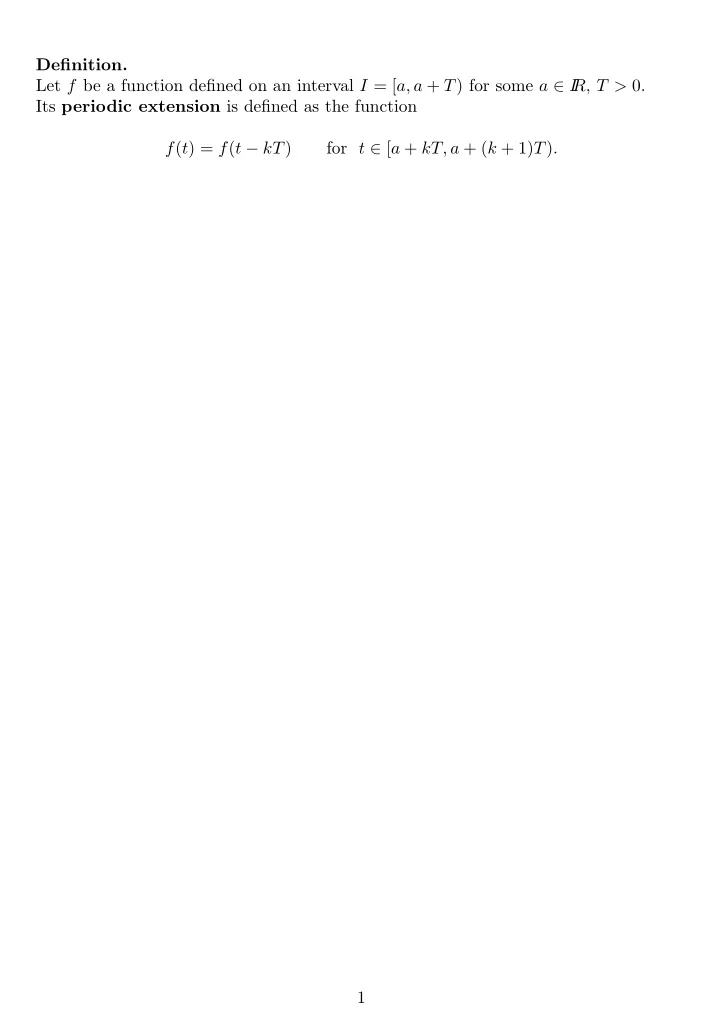

Definition. Let f be a function defined on an interval I = [ a, a + T ) for some a ∈ I R , T > 0. Its periodic extension is defined as the function f ( t ) = f ( t − kT ) for t ∈ [ a + kT, a + ( k + 1) T ) . 1
Theorem. Let f be a function that is T -periodic. Let ω = 2 π T . If the series ∞ a 0 � � � 2 + a k cos( kωt ) + b k sin( kωt ) k =1 converges to f ( x ) on I R uniformly, then necessarily T a k = 2 � f ( t ) cos( kωt ) dt pro k ∈ I N 0 , T 0 T b k = 2 � f ( t ) sin( kωt ) dt pro k ∈ I N. T 0 2
Definition. Let f be a function integrable on an interval [ a, a + T ]. We define its Fourier series as ∞ a 0 � � � 2 + a k cos( kωt ) + b k sin( kωt ) , k =1 where ω = 2 π T and T a k = 2 � f ( t ) cos( kωt ) dt pro k ∈ I N 0 , T 0 T b k = 2 � f ( t ) sin( kωt ) dt pro k ∈ I N. T 0 We write ∞ f ∼ a 0 � � � 2 + a k cos( kωt ) + b k sin( kωt ) . k =1 3
Theorem. (Jordan criterion) Let f be a function that is piecewise continuous on some interval I of length T , assume that it has derivative f ′ that is piecewise continuous on I . Consider its periodic extension, call it f again for simplicity. ∞ Let f ∼ a 0 � � � 2 + a k cos( kωt ) + b k sin( kωt ) . Then for every t ∈ I R we have k =1 ∞ = 1 a 0 � �� � � � � � � 2 + a k cos( kωt ) + b k sin( kωt ) lim f ( x ) + lim f ( x ) . 2 x → t − x → t + k =1 ∞ R , then a 0 � � If, moreover, f is continuous on I 2 + � a k cos( kωt ) + b k sin( kωt ) = f k =1 and the convergence of this series is uniform on I R . 4
Fourier series in amplitude-phase form : ∞ f ∼ a 0 � 2 + A k sin( kωt + ϕ k ) . k =1 5
Fourier series in complex form : ∞ � c k e ikωt , f ∼ k = −∞ where a + T � c k = 1 f ( t ) e − ikωt dt. T a 6
Definition. Let f ( t ) be a function integrable on I R . Its Fourier transform F [ f ]( ω ) is defined by the formula ∞ � f ( t ) e − iωt dt. F [ f ] : ω �→ −∞ Often we also write F [ f ] = ˆ f . 7
Theorem. Let f be a function integrable on I R that is continuous with possible exception of finitely many jump discontinuities. If we redefine f as f ( x ) = 1 f ( x − ) + f ( x + ) � � at 2 these points, then ∞ f ( t ) = 1 � f ( ω ) e iωt dω. ˆ 2 π −∞ 8
Fourier transform: Dictionary: F [1] = 2 πδ ( ω ); F [ δ ( t )] = 1; F [ H ( t )] = πδ ( ω ) + 1 2 iω ; F [sgn( t )] = iω ; F [ e − ω 0 | t | ] = 2 ω 0 ω 2 0 + ω 2 ; F [ e iω 0 t ] = 2 πδ ( ω − ω 0 ); ( ω 0 > 0) 1 1 F [ e iω 0 t H ( t )] = F [ t e iω 0 t H ( t )] = ω 0 + iω ; ( ω 0 + iω ) 2 ; ( ω 0 > 0) F [sin( ω 0 t )] = π F [cos( ω 0 t )] = π 2 i [ δ ( ω − ω 0 ) − δ ( ω + ω 0 )]; 2 i [ δ ( ω − ω 0 ) + δ ( ω + ω 0 )]. Grammar: F [ αf + βg ] = α F [ f ] + β F [ g ]; F [ f ( t − a )] = e − iaω ˆ F [ t f ( t )] = i ˆ f ′ ( ω ); f ( ω ); F [ e iat f ( t )] = ˆ F [ f ′ ( t )] = iω ˆ f ( ω − a ); f ( ω ). here ˆ f = F [ f ] 9
Recommend
More recommend